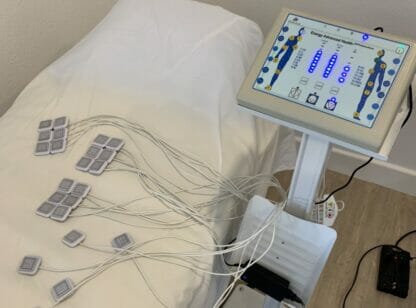It sounds like something out of an old science fiction movie, but ozone therapy is scientifically valid and used by certified doctors worldwide due to its therapeutic properties. In the United States, there are a small number of doctors trained and certified in ozone therapy.
The first ozone generator was patented in 1896 by Nikola Tesla. During WWI, topical ozone therapy was used by doctors on the battlefields to disinfect and heal wounds. In 2010, the Alvarado and Miramar water treatment plants of San Diego, California, initiated the use of ozone as their primary disinfectant.
Published research has demonstrated positive results of ozone therapy in heart disease, stroke, diabetes and diabetic foot ulcers, and various eye conditions (age-related macular degeneration, diabetic retinopathy, and glaucoma). Benefits have also been demonstrated in multiple sclerosis, fibromyalgia, chronic fatigue syndrome, chronic viral hepatitis, acute herpes/shingles outbreak, lumbar and cervical disc herniation.
How Does Ozone Therapy Work?
Ozone gas consists of three oxygen atoms as opposed to the two oxygen molecules found in the air we breathe. It occurs naturally and creates the ozone layer, Earth’s protective layer from the sun’s ultraviolet radiation.
Ozone therapy is a novel, safe, and effective therapy that utilizes medical grade oxygen/ozone gas created by an advanced medical device in a certified doctor’s office. It is administered in a number of different ways: the most common is intravenous (IV) ozone; other methods include musculoskeletal injections (similar to prolotherapy and platelet rich plasma), topical applications, and rectal and bladder insufflation. Direct injection of ozone gas into the venous or arterial system is no longer a commonly used technique due to many reported adverse effects.
Ozone therapy is thought to exert most of its therapeutic effects by activating various proteins that regulate genetic information in DNA and has been found to reduce chronic inflammation (oxidative stress); support tissue repair (enhances the release of growth factors); increase cellular energy; reduce oxidized LDL (“bad cholesterol”); improve oxygen delivery to cells and circulation; up-regulate the antioxidant system, and modulate the immune system.
Is Ozone Therapy Safe?
When administered by a certified and trained doctor, ozone therapy is extremely safe. The most common non-serious adverse effects include bleeding and bruising at the injection site. The inhalation of ozone gas can lead to airway hyper-reactivity and inflammation which can significantly exacerbate patients with chronic obstructive pulmonary disease (COPD). Similar to other injection therapies, there is a potential risk of infection, light headedness and blood clot.
However, using universal safety precautions these risks are significantly reduced, if not completely eliminated. In 1980, the German Medical Society for Ozone Therapy surveyed 644 ozone therapists and found that of 5.5 million ozone treatments of 384,775 patients, the complication rate was 0.000007% or 1 in every 137, 500 treatments.
Ozone therapy is safe, effective, and when combined with a comprehensive treatment plan, may greatly benefit your health.
Dr. Wilson is a naturopathic primary care doctor with a focus on cardiometabolic and digestive health at Live Well Clinic in La Quinta. He is certified in ozone therapy and can be reached at livewellclinic.org or call (760) 771.5970.
Sources available upon request.












































Comments (0)